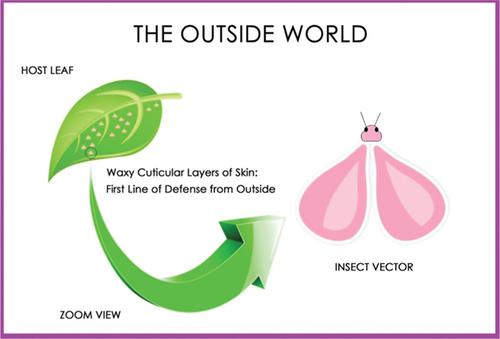当前位置:
X-MOL 学术
›
Curr. Genomics
›
论文详情
Our official English website, www.x-mol.net, welcomes your feedback! (Note: you will need to create a separate account there.)
Host Plant Strategies to Combat Against Viruses Effector Proteins
Current Genomics ( IF 2.6 ) Pub Date : 2020-09-16 , DOI: 10.2174/1389202921999200712135131 Avinash Marwal 1 , Rajarshi Kumar Gaur 2
Current Genomics ( IF 2.6 ) Pub Date : 2020-09-16 , DOI: 10.2174/1389202921999200712135131 Avinash Marwal 1 , Rajarshi Kumar Gaur 2
Affiliation

|
Viruses are obligate parasites that exist in an inactive state until they enter the host body. Upon entry, viruses become active and start replicating by using the host cell machinery. All plant viruses can augment their transmission, thus powering their detrimental effects on the host plant. To diminish infection and diseases caused by viruses, the plant has a defence mechanism known as pathogenesis-related biochemicals, which are metabolites and proteins. Proteins that ultimately prevent pathogenic diseases are called R proteins. Several plant R genes (that confirm resistance) and avirulence protein (Avr) (pathogen Avr gene-encoded proteins [effector/elicitor proteins involved in pathogenicity]) molecules have been identified. The recognition of such a factor results in the plant defence mechanism. During plant viral infection, the replication and expression of a viral molecule lead to a series of a hypersensitive response (HR) and affect the host plant's immunity (pathogen-associated molecular pattern-triggered immunity and effector-triggered immunity). Avr protein renders the host RNA silencing mechanism and its innate immunity, chiefly known as silencing suppressors towards the plant defensive machinery. This is a strong reply to the plant defensive machinery by harmful plant viruses. In this review, we describe the plant pathogen resistance protein and how these proteins regulate host immunity during plant-virus interactions. Furthermore, we have discussed regarding ribosome-inactivating proteins, ubiquitin proteasome system, translation repression (nuclear shuttle protein interacting kinase 1), DNA methylation, dominant resistance genes, and autophagy-mediated protein degradation, which are crucial in antiviral defences.
中文翻译:

宿主植物对抗病毒效应蛋白的策略
病毒是专性寄生虫,在进入宿主体内之前一直处于非活动状态。进入后,病毒变得活跃并开始使用宿主细胞机制进行复制。所有植物病毒都可以增强它们的传播,从而加剧它们对宿主植物的有害影响。为了减少由病毒引起的感染和疾病,植物有一种防御机制,称为发病机制相关的生化物质,即代谢物和蛋白质。最终预防致病疾病的蛋白质称为R蛋白。已经鉴定了几种植物 R 基因(证实抗性)和无毒蛋白 (Avr)(病原体 Avr 基因编码的蛋白质 [与致病性有关的效应子/诱导子蛋白])分子。对这种因素的识别导致了植物防御机制。在植物病毒感染期间,病毒分子的复制和表达导致一系列过敏反应(HR)并影响宿主植物的免疫(病原体相关分子模式触发免疫和效应子触发免疫)。Avr 蛋白呈现宿主 RNA 沉默机制及其先天免疫,主要称为植物防御机制的沉默抑制因子。这是对有害植物病毒对植物防御机制的有力回应。在这篇综述中,我们描述了植物病原体抗性蛋白以及这些蛋白在植物-病毒相互作用过程中如何调节宿主免疫。此外,我们还讨论了核糖体失活蛋白、泛素蛋白酶体系统、翻译抑制(核穿梭蛋白相互作用激酶 1)、DNA 甲基化、显性抗性基因、
更新日期:2020-09-16
中文翻译:

宿主植物对抗病毒效应蛋白的策略
病毒是专性寄生虫,在进入宿主体内之前一直处于非活动状态。进入后,病毒变得活跃并开始使用宿主细胞机制进行复制。所有植物病毒都可以增强它们的传播,从而加剧它们对宿主植物的有害影响。为了减少由病毒引起的感染和疾病,植物有一种防御机制,称为发病机制相关的生化物质,即代谢物和蛋白质。最终预防致病疾病的蛋白质称为R蛋白。已经鉴定了几种植物 R 基因(证实抗性)和无毒蛋白 (Avr)(病原体 Avr 基因编码的蛋白质 [与致病性有关的效应子/诱导子蛋白])分子。对这种因素的识别导致了植物防御机制。在植物病毒感染期间,病毒分子的复制和表达导致一系列过敏反应(HR)并影响宿主植物的免疫(病原体相关分子模式触发免疫和效应子触发免疫)。Avr 蛋白呈现宿主 RNA 沉默机制及其先天免疫,主要称为植物防御机制的沉默抑制因子。这是对有害植物病毒对植物防御机制的有力回应。在这篇综述中,我们描述了植物病原体抗性蛋白以及这些蛋白在植物-病毒相互作用过程中如何调节宿主免疫。此外,我们还讨论了核糖体失活蛋白、泛素蛋白酶体系统、翻译抑制(核穿梭蛋白相互作用激酶 1)、DNA 甲基化、显性抗性基因、



























 京公网安备 11010802027423号
京公网安备 11010802027423号